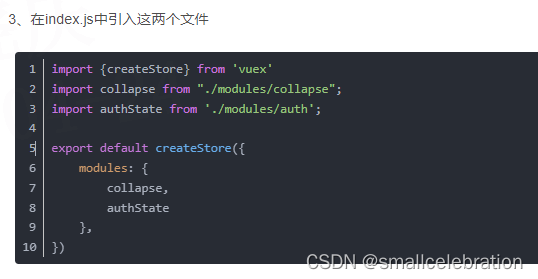1、首先组件的使用步骤:
使用nanoid生成独一无二的id比uuid更加轻量
1.创建组件.vue文件,组件名name(首字母大写)
2.引入组件:import Student from "./components/Student.vue" (script标签下)
3.注册组件:当前组件name属性与data平级,components注册局部组件{Student}
4.使用组件:在当前组件中使用<Student/>组件标签
const comp=Vue.extends({ 创建组件})
2、使用ref属性:被用来给元素或子组件注册引用信息(id的替代者)
应用在html标签上获取的是真实DOM元素,应用在组件标签上是组件实例对象(vc)
使用方式:
1. 打标识:```<h1 ref="xxx">.....</h1>``` 或 ```<School ref="xxx"></School>```
2. 获取:```this.$refs.xxx``` 获取实例,获取数据
3.父向子传值:使用自定义属性props传参
在子组件标签上自定义属性,子组件props:['xxx','sss'],或者props:{"xxx":{type:number,default:0}}
4.子向父传值:
1.通过父组件给子组件传递 函数类型(一个函数) 的props:(扩展)
1.父组件通过属性传递一个函数给子组件//父组件中代码<School :getSchoolName="getSchoolName"/>methods: {getSchoolName(name){console.log('App收到了学校名:',name)}}//子组件中代码props:['getSchoolName'],//在某methods里面的函数里面调用该函数this.getSchoolName(this.name)//传递一个子组件中的数据name2.通过父组件给子组件绑定一个自定义事件实现:(第一种写法,使用@或v-on)
//父组件中代码 给子组件自定义atguigu事件
<Student @atguigu="getStudentName" />
//在methods中定义时间getStudentName(name,...params){console.log('App收到了学生名:',name,params)this.studentName = name},//子组件中 通过this.$emit('atguigu',this.name)sendStudentlName(){//触发Student组件实例身上的atguigu事件this.$emit('atguigu',this.name,666,888,900)// this.$emit('demo')// this.$emit('click')},
3.通过父组件给子组件绑定一个自定义事件实现:(第二种写法,使用ref)
父组件中this.$refs.student.$on('自定义事件名',function)
//父组件给子组件 打上ref标识 定义自定义事件 this.$refs.student.$on('atguigu',function)<Student ref="student"/>mounted() {this.$refs.student.$on('atguigu',this.getStudentName) //绑定自定义事件
// this.$refs.student.$once('atguigu',this.getStudentName) //绑定自定义事件(一次性)},getStudentName(name,...params){console.log('App收到了学生名:',name,params)this.studentName = name},//子组件中 去触发组件上的自定义事件this.$emit('atguigu',this.name)解绑自定义事件:在子组件内部解绑this.$off('atguigu')
销毁当前组件实例:this.$destroy()
unbind(){this.$off('atguigu') //解绑一个自定义事件// this.$off(['atguigu','demo']) //解绑多个自定义事件// this.$off() //解绑所有的自定义事件},death(){this.$destroy() //销毁了当前Student组件的实例,销毁后所有Student实例的自定义事件全都不奏效。}5.sessionstorage/localStorage:只能存储字符串
localStorage.setItem('token',JSON.Stringfy()) JSON.parse(localStorage.getItem('token'))
6.全局事件总线传参(Vue.prototype.$bus=this或new Vue())//组件都能访问到$bus
***********************注意:使用的局限性***************************
总之,监听bus总线的事件,必须要函数中,但是该函数执行的时候,跟bus总线无关。
路由组件中:两个组件不在一个页面,bus总线即使改变了值,当点击另一个路由路径的时候,data函数又将值初始化了,
所以说,bus总线作用的两个组件应该在同一页面中。当然,可以用一个仓库来存储这个改变的值,比如:vuex、webStorage、数据库等等。
vue中兄弟组件之间的联动,兄弟组件之间的传值_叨唠的博客-CSDN博客_vue兄弟组件传值兄弟组件之间的传值,使得兄弟组件之间可以联动,相互操作方法1:借助父组件,让两个兄弟组件可以联动,子组件A将值传递给父组件,父组件再将值传递给子组件B第一步:子组件A传值给父组件通过$emit将e.target.innerText传递给父组件<template> <div class="initail"> <ul> &l... https://blog.csdn.net/zyz00000000/article/details/84824623
https://blog.csdn.net/zyz00000000/article/details/84824623
//安装全局事件总线
import Vue from "vue"
import App from "./App.vue"Vue.config.productionTip=falsenew Vue({el:'#app',render:h=>h(App),beforeCreate(){Vue.prototype.$bus=this//安装全局事件总线}
})//发送数据方组件 this.$bus.$emit('aiguigu',this.name)methods:{sendStudentName(){this.$bus.$emit('hello',this.name)}}//接收数据方组件 this.$bus.$on('hello',(data)=>{ 收到事件data//自定义事件回调})mounted() {// console.log('School',this)this.$bus.$on('hello',(data)=>{console.log('我是School组件,收到了数据',data)})},
//最好在销毁组件之前,解绑自定义事件beforeDestroy() {this.$bus.$off('hello')},}7.消息的发布订阅pubsub-js
以下是详细用法
vue组件间的通信之pubsub-js - 显示账号 - 博客园本文介绍使用发布订阅的方式进行vue组件间的通信 我认为这种方式比较自由, 不存在组件间的关系问题 1. 首先安装pubsub-js npm install --save pubshttps://www.cnblogs.com/z-qinfeng/p/12387268.html1.npm install --save pubsub-js
2.import pubsub form “pubsub-js”
3.订阅消息pubsub.subscribe('频道',(数据)=>{//回调}) (beforeDestroy中pubsub.unsubscribe(pubId))见下方示例
mounted() {// console.log('School',this)/* this.$bus.$on('hello',(data)=>{console.log('我是School组件,收到了数据',data)}) */this.pubId = pubsub.subscribe('hello',(msgName,data)=>{console.log(this)// console.log('有人发布了hello消息,hello消息的回调执行了',msgName,data)})},beforeDestroy() {// this.$bus.$off('hello')pubsub.unsubscribe(this.pubId)},4.发布消息pubsub.publish('频道',数据)
8.开启代理服务器Vue.config.js
配置参考 | Vue CLI![]() https://cli.vuejs.org/zh/config/#devserver-proxy
https://cli.vuejs.org/zh/config/#devserver-proxy
//开启代理服务器(方式一)/* devServer: {proxy: 'http://localhost:5000'}, *///开启代理服务器(方式二)devServer: {proxy: {'/atguigu': {target: 'http://localhost:5000',pathRewrite:{'^/atguigu':''},// ws: true, //用于支持websocket// changeOrigin: true //用于控制请求头中的host值},'/demo': {target: 'http://localhost:5001',pathRewrite:{'^/demo':''},// ws: true, //用于支持websocket// changeOrigin: true //用于控制请求头中的host值}}}9.vue-resource发起请求(与axios作用相同)
vue-resource基本使用方法 - 古兰精 - 博客园一、vue-resource特点 1、体积小:vue-resource非常小巧,在压缩以后只有大约12KB,服务端启用gzip压缩后只有4.5KB大小,这远比jQuery的体积要小得多。 2、支持主流https://www.cnblogs.com/goloving/p/8665421.html
10.插槽的使用
1.插槽:在组件中可以用<slot>标签占位,挖一个坑留着,在使用组件标签时,用双标签,往里面去填充内容,从而达到组件可以多样化的效果
2.具名插槽:
//组件中代码 有两个插槽 所以给name属性区别出插槽
<div class="category"><h3>{
{title}}分类</h3><!-- 定义一个插槽(挖个坑,等着组件的使用者进行填充) --><slot name="center">我是一些默认值,当使用者没有传递具体结构时,我会出现1</slot><slot name="footer">我是一些默认值,当使用者没有传递具体结构时,我会出现2</slot></div>//使用组件的位置 可以使用template标签—+ v-slot:footer
<Category title="电影">
<video slot="center" controls src="http://clips.vorwaerts-gmbh.de/big_buck_bunny.mp4"></video><template v-slot:footer><div class="foot"><a href="http://www.atguigu.com">经典</a><a href="http://www.atguigu.com">热门</a><a href="http://www.atguigu.com">推荐</a></div><h4>欢迎前来观影</h4></template></Category>//或者 直接slot="footer" 直接等于对应的slot标签名
<Category title="游戏" ><ul slot="center"><li v-for="(g,index) in games" :key="index">{
{g}}</li></ul><div class="foot" slot="footer"><a href="http://www.atguigu.com">单机游戏</a><a href="http://www.atguigu.com">网络游戏</a></div></Category>3.作用域插槽:数据也在组件中,不在使用者身上,当使用者需要拿到组件中的数据时,可以通过给<slot>标签添加自定义属性传值给使用者,在父组件中<template scope="{自定义属性}">通过解构赋值得到该数据
//子组件中slot标签自定义属性传值
<template><div><slot :games="games" msg="hello">我是一些默认内容</slot></div>
</template><script>
export default {name:'Category',props:['title'],date(){return {games:['红色警戒','穿越火线','劲舞团','超级玛丽'],}}
}
</script>
//父组件中 template标签上 scope=“{games}” 或 slot-scope="{games}"<Category title="游戏"><template scope="atguigu"><ul><li v-for="(g,index) in atguigu.games" :key="index">{
{g}}</li></ul></template></Category>//slot-scope="{games}"<Category title="游戏"><template slot-scope="{games}"><h4 v-for="(g,index) in games" :key="index">{
{g}}</h4></template></Category>
11.vuex:状态管理构架
VueX 是一个专门为 Vue.js 应用设计的状态管理构架,统一管理和维护各个vue组件的可变化状态(你可以理解成 vue 组件里的某些 data )。
Vuex有五个核心概念:
state, getters, mutations, actions, modules。
1. state:vuex的基本数据,用来存储变量 //this.$store.state.xxx 获取值
2. getter:从基本数据(state)派生的数据,相当于state的计算属性
3. mutation:提交更新数据的方法,必须是同步的(如果需要异步使用action)。每个 mutation 都有一个字符串的 事件类型 (type) 和 一个 回调函数 (handler)。this.$store.commit
回调函数就是我们实际进行状态更改的地方,并且它会接受 state 作为第一个参数,提交载荷作为第二个参数。
4. action:和mutation的功能大致相同,不同之处在于 ==》1. Action 提交的是 mutation,而不是直接变更状态。 2. Action 可以包含任意异步操作。this.$store.dispatch
5. modules:模块化vuex,可以让每一个模块拥有自己的state、mutation、action、getters,使得结构非常清晰,方便管理。

模块化: 方法一使用mapState等

import {mapState,mapGetters,mapMutations,mapActions} from 'vuex'export default {name:'Count',data() {return {n:1, //用户选择的数字}},computed:{//借助mapState生成计算属性,从state中读取数据。(数组写法)...mapState('countAbout',['sum','school','subject']),...mapState('personAbout',['personList']),//借助mapGetters生成计算属性,从getters中读取数据。(数组写法)...mapGetters('countAbout',['bigSum'])},methods: {//借助mapMutations生成对应的方法,方法中会调用commit去联系mutations(对象写法)...mapMutations('countAbout',{increment:'JIA',decrement:'JIAN'}),//借助mapActions生成对应的方法,方法中会调用dispatch去联系actions(对象写法)...mapActions('countAbout',{incrementOdd:'jiaOdd',incrementWait:'jiaWait'})},mounted() {console.log(this.$store)},模块化:方法二(使用this.$store)

27.vue组件间完整传值方式 代理服务器 插槽 vuex 路由按需加载_vuex modules太多 可以按需加载_smallcelebration的博客-CSDN博客1、首先组件的使用步骤:1.创建组件.vue文件,组件名name(首字母大写)2.引入组件:import Student from "./components/Student.vue" (script标签下)3.注册组件:当前组件name属性与date平级,components注册局部组件{Student}4.使用组件:在当前组件中使用<Student>组件标签constcomp=Vue.extends({创建组件})2、使用ref属性:被用来给元素或子组件注册引用信..https://blog.csdn.net/samllucky/article/details/122797557
12.路由按需加载:三种方法
vue项目实现路由按需加载(路由懒加载)的3种方式_岁末zzz的博客-CSDN博客_vue路由按需加载1. vue异步组件技术vue-router配置路由,使用vue的异步组件技术,可以实现按需加载。但是,这种情况下一个组件生成一个js文件。举例如下:{ path: '/promisedemo', name: 'PromiseDemo', component: resolve => require(['../co...https://blog.csdn.net/weixin_43953710/article/details/103027683?spm=1001.2101.3001.6650.1&utm_medium=distribute.pc_relevant.none-task-blog-2~default~BlogCommendFromBaidu~Rate-1.pc_relevant_aa&depth_1-utm_source=distribute.pc_relevant.none-task-blog-2~default~BlogCommendFromBaidu~Rate-1.pc_relevant_aa&utm_relevant_index=2